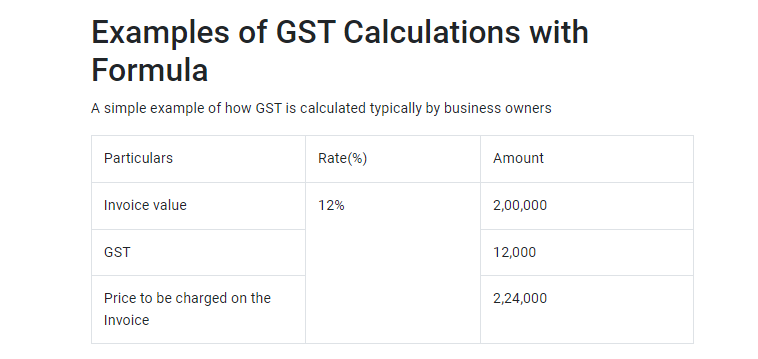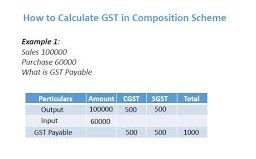Thanks to the GST tax implementation, taxpayers can calculate and be aware of the taxes they need to pay for every supply of goods and services point.
There are different GST rates for different categories, which taxpayers need to remember when calculating GST. The rates applicable under the new tax structure are 5%, 12%, 18% and 28%.
1. Calculating GST liability for supplies
Compared to the old Service Tax Calculation or VAT calculation, there are many changes in the GST liability calculation. Here are the following points you need to follow to finalize the GST liability for any month –
- Step 1 – First, you need to get a loss account and draft the profit for the month you calculate the GST. You need to take account of all the income or sales as well as the expenses.
- Step 2 – the profit’s debit side and the loss account needs to be checked. You must also search for services or purchases from unregistered suppliers or dealers. You must pay the GST for any service or purchase from an unregistered supplier or dealer. These types of inward supplies and purchases are categorized as reverse charge provisions. You also need to ensure you have paid all the reverse charges for the services or purchases taken from even the registered suppliers or dealers.
- Step 3 – Take account of any advance that you have received or paid for which the bills have not been paid. You need to clear GST payments on those advances, too.
- Step 4 – After you have completed all the above steps, your gross GST liability will be – GST on outward supply added with GST on Reverse Charge added with GST on Advances received during that specific month.
- Step 5 – Now, the Gross GST Liability you got by counting everything in Step 4; you need to subtract it from the Input Tax Credit added with GST paid on Reverse Charge.
- Step 6 – The number you will get at the end of step 5 will be the NET GST Liability.
- Step 7 – You must determine whether you possess any TCS or TDS Credit to pay the NET GST Liability Check. If you have the TCS or TDS Credit, you can also deduct them.
- Step 8 – after completing the calculation till Step 7, the number you acquire is the money you need to pay by challan in the Bank.
However, make sure to mention the type of GST – IGST, CGST, SGST correctly while you are balancing the payment of GST in the Bank or adjusting ITC.
2. Business and individual GST computation methods
Here is a simple method of calculating GST –
For example, if a product or a service is sold at 5000 rs and the applicable rate of GST is 5%, then the net price will be calculated as = 5000 + (5000x (5/100)) = 5000 + 250 = 5250 rs.
Here is the basic GST formula to calculate GST –
When calculating the tax applicable to a specific good or product, the process becomes much simpler when the indirect taxation regime is simplified. Based on the nature of the supply (interstate or intrastate), the GST applied to the goods and services can now be calculated with the help of GST rates.
Here is how to calculate GST for Intra-state supplies –
- CGST – GST rate applicable / 2 (for 18%, CGST will be 18/2 = 9%)
- UTGST or SGST – GST rate applicable / 2 (for 18%, UTGST or SGST will be 18/2 = 9%)
This implies that the applicable GST rate will be SGST/UTGST + CGST.
However, when interstate GST transactions are in question, the GST is the applicable GST rate. The GST Compensation Cess must be applied for the right tax calculations wherever necessary. Thus, the simple formula of GST calculation is –
- Original Cost = GST inclusive price x GST rate / (100 + GST rate %)
- GST Amount = GST inclusive price x 100 / (100 + GST rate %)


3. Determining GST liability for various supplies
The supplies that come under the GST liability include the supply of goods and services such as — money transfer, sale, rental, exchange, lease, disposal, license, and barter. Regarding liabilities regarding GST, one needs to heed whether the import of services is in the course of business.
The amount of tax that needs to be paid and the taxability of the supply of goods and services are also considered liabilities. Aspects like the place of supply, time of supply, and location of supply also play a massive role in determining the GST liability for the various supplies.
4. GST calculation procedures for businesses
Any business with a turnover exceeding 40 lakh rs in one financial year must register under GST. For service providers, the threshold is 20 lakh rs a financial year.
After GST implementation, businesses can purchase 50,000 rs worth of supplies at the GST rate of 12% and provide a service to a different company for 80,000 rs at the GST rate of 18. In this case, they can relish the tax credits paid on purchases after GST implementation. The calculations for that are mentioned below —

5. Individual GST liability assessment for supplies
The determination of tax liability under GST law is called the Assessment. Here are some of the assessments under GST —
- Self-assessment
- Provisional assessment
- Summary assessment
- Scrutiny assessment
- Assessment of unregistered persons
- Assessment of non-filers of returns
- Best judgment assessment
The taxpayer can do self-assessment, but other than that, the tax authorities do all other categories of assessments.
If you are a registered taxable person, you can assess the tax you need to pay. For every tax period, you can also furnish a return.
6. Guidelines for accurate GST liability calculation
The guidelines for the accurate GST liability calculation are the steps following, which will allow you to get an accurate GST amount that you are responsible for paying to the government of India. The steps mentioned earlier in the article, where we discussed calculating GST liabilities, are:
You need to be familiar with the GST rates that influence the GST liability calculation. Under the GST law, you can find 7 specified rates that apply to the goods. In the GST Rates Booklet for Goods, all of these rates are classified under “Schedule” and they are —
| Schedule I | Nil Rated |
| Schedule II | 0.25% |
| Schedule III | 3% |
| Schedule IV | 5% |
| Schedule V | 12% |
| Schedule VI | 18% |
| Schedule VII | 28% |
There are 5 schedules for services under GST in GST Rates Brrojlet for Services.GST rates for services differ from the rates for goods, and they are —
| Schedule I | Nil Rated |
| Schedule II | 5% |
| Schedule III | 12% |
| Schedule IV | 18% |
| Schedule V | 28% |
Conclusion
GST is the indirect tax implemented by the Government of India and needs to be paid by every taxable person for the supply of goods and services. The businesses and the individual both have to pay taxes based on the nature of their supply, and both of them can calculate their GST amount either with the help of the formula explained above or with the help of a GST calculator.
FAQs
-
What does the GST inclusive amount mean?
The product’s total value after the inclusion of the GST is referred to as the GST-inclusive amount, which means the value of the original product + the GST is considered the GST-inclusive amount. The GST charge won’t be separately charged to the customer.
-
What does the GST exclusive amount mean?
When the product’s original value is measured by subtracting the GST charged on that product, the amount is considered the GST-exclusive amount.
-
What is the current rate of GST in India?
The GST rate depends entirely on the goods and services being taxed, but the current GST rate starts from 0% and can go up to 28% in India.
-
How are the advance GST payments calculated?
The rate of goods and services expected to be supplied is required to calculate the GST on advance payments. The supplier of the goods and services must generate a receipt voucher or a tax invoice that showcases the GST charge on the advance payment.
-
How to calculate the discount price GST?
The final selling price of the goods and services is considered when calculating GST. this goes for the offers and discount prices as well. That’s why if you are counting the GST charge on the discount price, take the reduced selling price to count your GST.
-
How to calculate composite supply GST?
The principal supply, which is responsible for the composite supply, is accounted for when calculating GST on the composite supply. Whatever GST applies to the main supply needs to be used for calculating the GST which is to be charged on the composite supply.
-
Are international transactions susceptible to the GST calculator?
No, international payments cannot be charged with a GST amount calculated in the GST calculator. GST is the tax that the government of India levies; hence, the tax is to be paid for domestic transactions only.
-
Do you have to use a GST calculator when calculating GST?
No laws mandate the GST calculator as a must-have in the process of GST calculation. However, for accurate results, one is recommended to use a GST calculator for GST calculation.
-
Can you use the GST calculator for Multiple GST rates?
The GST calculator can be used even when multiple GST rates are in question. All you need to do is put the correct GST rate for each service or good supplied in the transaction while calculating the GST.
-
Does every good and service get charged with GST?
No, not every good and service gets charged with GST, as some goods and services are not subject to GST. Other goods and services get taxed at different rates depending on the nature of the supply.
